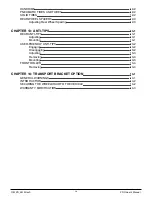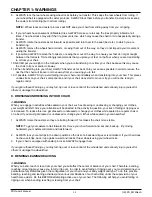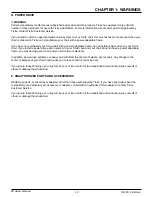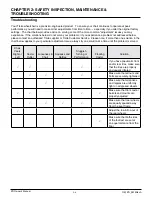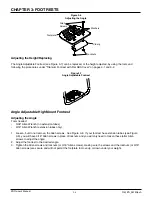
1-13
ZR Owner’s Manual
OM_ZR_0913RevA
CHAPTER 1: WARNINGS
C. UpHOLSTERY FABRIC
I
WARNING
1. If the fabric of your seat sling or seat back becomes worn or torn, ALWAYS replace it immediately. If you fail to do
so, the seat sling or seat back upholstery may sag or fail.
2. The upholstery on your chair is flame retardant. Laundering or allowing the upholstery to become wet repeatedly
will reduce the flame retardant qualities of the fabric.
3. DO NOT “drop down” into your chair. By placing undue force on the upholstery, you will weaken the fabric and
it may become worn sooner than it otherwise would. If you do “drop down” into your chair on a regular basis,
inspect and replace the upholstery more often.
4. The upholstery on your chair will weaken with age and use. Regularly inspect your upholstery for fraying, thin
spots, or stretching of the fabric at the rivet holes.
If you ignore these Warnings, you may fall, tip over or lose control of the wheelchair and seriously injure yourself or
others or damage the wheelchair.
D. SEATING SYSTEMS
I
WARNING
TiLite does not sell any seating systems specifically designed for use with TiLite wheelchairs, nor does TiLite
recommend any particular seating system. If your doctor or therapist recommends that you use a seating system with
your TiLite chair, always consult with an authorized TiLite dealer to determine if the recommended seating system is
compatible with your TiLite chair. In addition, the following Warnings must be followed:
1. If you add a seating system to your TiLite chair, you will affect its center of balance. This may cause the chair to
tip over. Therefore, NEVER install a new seating system on your own. Instead, have it installed by an authorized
TiLite dealer who can assist you in making other necessary adjustments to ensure your center of balance is
maintained as closely as possible to what you are used to.
2. As with other changes to the configuration of your chair that affect its center of balance, if you add a seating
system to your TiLite chair, ALWAYS use anti-tips until you have fully learned to control your chair in its new
configuration.
3. Keep in mind that adding a seating system also may inhibit the proper operation of a folding back wheelchair.
If you ignore these Warnings, you may fall, tip over or lose control of the wheelchair and seriously injure yourself or
others or damage the wheelchair.
E. pOSITIONING OR SEAT BELTS
I
WARNING
TiLite hook & loop, non-padded seat belts and Bodypoint
®
non-padded hip belts, both of which are optional
equipment, are intended ONLY for use as a positioning aid for simple positioning needs, such as posterior pelvic tilt.
These belts will not be sufficient for persons with more involved positioning needs. Only your health care advisor can
determine the proper positioning products for your situation. If used improperly, positioning or seat belts can cause
severe injury or even death. If your health care advisor has instructed you to use positioning or seat belts, make sure
they instruct you on the proper usage of such belts, and such professional should supervise your use of such belts to
ensure you can use them safely.
1. Belts must fit snugly in order to work properly. However, they must not be so snug they interfere with your
breathing. Your health care advisor should be able to slide his or her open hand flat between the belt and your
body.
2. Make sure you do not slide down in your chair while wearing a belt. If this should happen, you may suffer chest
compression or be suffocated due to pressure from the belt.
3. Do not use a positioning or seat belt unless you are capable of removing the belts easily in an emergency. If you
cannot do this, consult with your health care advisor for other options to help with your posture.
4. There are devices that help to keep you from sliding down in the seat of your wheelchair, such as a pelvic wedge.
Consult with your health care advisor to find out if you need to use such a device in conjunction with positioning or
seat belts to mitigate the risks described above.

